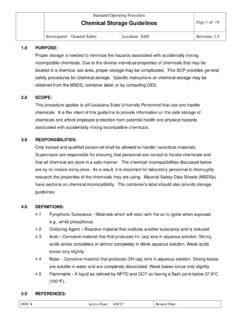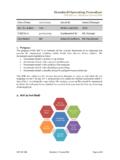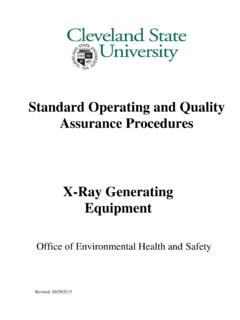Transcription of Standard operating procedure Transition to recovery
1 Standard operating procedure Transition to recovery A phased Transition for dental practices towards the resumption of the full range of dental provision Published 28 August 2020: Version 3. 1. Contents Introduction .. 3. Section 1: Key 6. Section 2: Supporting the Dental 12. Section 3: Initial operating Capacity Care Planning .. 16. Appendix 1: Guidance for infection prevention and control in dental care settings authored by Public Health England (PHE) .. 23. Appendix 2: Practice Checklist .. 40. Appendix 3: Arranging a remote point of contact .. 45. Completing a remote point of 47. Appendix 4: Clinical guideline 3 - Management of periodontal treatment (non-AGP) .. 50. Appendix 5: Clinical guideline - Advanced Minimally Invasive Restorative Dentistry (AMIRD): caries management .. 54. Factors determining caries intervention .. 55. AMIRD - Non-invasive 56. AMIRD - Micro-invasive caries management .. 57. AMIRD - Minimally invasive restorations, risk-mitigated AGP principles .. 59.
2 Appendix 6: Management of caries for the paediatric patient .. 60. Appendix 7: Management of (non-AGP) Endodontics .. 62. Appendix 8: Approaches for clinically vulnerable and clinically extremely vulnerable patients .. 67. 2. Introduction On 28 May 2020 we wrote to NHS dental practices setting out the arrangements to restart face to face dental services from 8 June. We also published the first version of this Transition to recovery SOP. Since then we have seen increasing numbers of practices opening for face to face care recognising some of the challenges that needed to be overcome in terms of restructuring the approach to patient flows to account for a COVID-secure environment and the complexities associated with Infection prevention control and aerosol generating procedures . I am incredibly grateful to all those who have risen to the various challenges and for their ongoing commitment to patient care. The dental Transition to recovery SOP sits within the context of the NHS's phased approach to dealing with the pandemic and on the 31 July NHS England and NHS.
3 Improvement published its letter about the third phase of the NHS response to COVID-19, which stated: Dental practices should have now mobilised for face-to-face interventions. We recognise that capacity is constrained, but will support practices to deliver as comprehensive a service as possible'. During this phase, the baseline expectation is: Practices should be open for face to face care unless there are specific circumstances which prevent this and arrangements should be agreed with NHS commissioners. Practices should prioritise urgent dental care (UDC) provision, with flexibility for practices to do what is best for their patients. Detail is covered in the revised Standard operating procedures for urgent dental care (UDC SOP), which should be read in conjunction with this SOP. Progression towards the resumption of an increasing range of dental care, including aerosol generating procedures (AGP), risk-managed by individual practices subject to following the necessary IPC and PPE requirements.
4 We recognise the constraints on capacity associated with the current infection prevention control procedures , and are looking to support practices in this regard, for example the Fit Tester Training programme, and the work across the UK being taken forward by the Scottish Dental Clinical Effectiveness Programme on AGPs and fallow time. Central to the phased Transition of dental services and the resumption of all service provision is the acknowledged clinical judgement of practitioners and their ability to risk manage the delivery of dental care. This document is designed to provide supporting guidance for the initial Transition from recommencing face to face care towards the full resumption of dental care services; a practice-led, progressive approach. 3. In restoring service provision, we have a collective responsibility to: Monitor safety and assure the protection of the public, our patients and our dental workforce. Remain agile in our response to a re-imposition of public health measures, be it a local or national requirement to mitigate risk of COVID-19 transmission.
5 We all recognise the necessity for enhanced safety standards , including PPE and IPC. This will impact on tempo of clinical care, practice capacity and prioritisation of patients. The standards for IPC and PPE have been produced by Public Health England and must be adhered to. These standards are included in this SOP. (Appendix 1). They are the national benchmark and minimum expectation for safe practice and the Standard expected by the regulators. In delivering face-to-face dental care, minimising AGPs and the decision to defer functional and reconstructive work will need to be central to treatment planning. In supporting practitioners to adopt the clinically sound option to stabilise ahead of restoration, the principles are summarised and supported by the Note for Avoidance of Doubt: Provision of Phased Treatments The limitations in AGPs present an opportunity to re-think our approach to care pathways. The patient-focused, team-delivered minimum intervention oral healthcare philosophy helps in taking on the current challenges in delivering dental care.
6 The philosophy with its four interlinking domains of identifying the problem, prevention &. control, minimally invasive treatments and suitable recall strategies dependent upon longitudinal disease susceptibility, underpins all disciplines of dentistry. While dental teams may use a variety of acceptable techniques to risk manage care, the guidelines for remote consultations, non-AGP periodontal treatment, restorative and paediatric dental care contained in this SOP provide an aide memoire to best practice, minimising AGPs and delivering quality health outcomes. 4. We will need to support our patients in understanding the rationale behind the dental care management options. With patients and carers fully engaged in the shared decision-making, the opportunity to actively apply minimally invasive oral care brings us a step closer to breaking the repeat intervention cycle . The SOP is designed to support the practice through Transition and the shift towards a preventative and minimally invasive clinical approach that meets the current clinical challenges.
7 The SOP will also assist the Dental Team in fulfilling its responsibility with respect to the GDC standards for the Dental Team1 and in particular: Standard : You must provide good quality care based on current evidence and authoritative guidance You must find out about current evidence and best practice which affect your work, premises, equipment and business and follow them. If you deviate from established practice and guidance, you should record the reasons why and be able to justify your decision. As a framework and evidenced-based approach the intention is to support the provision of high-quality care in a safe clinical environment, in partnership with our patients. The pace of Transition , as with the prevention and intervention decisions managed every day, in every dental surgery, will be set by the clinical leadership in each practice. Sara Hurley Chief Dental Officer for England 1 5. Section 1: Key Principles Our shared goal is to deliver the safe and effective provision of the full range of care in all practices.
8 Our enduring priorities are the protection of patients, the dental team and the wider community. It remains a significant responsibility of the whole dental team to ensure that the risk of transmission of COVID-19 between patients, staff, staff and patients, is minimised. The decisions on pace and patient priorities, as ever, sit with the individual practitioner, who is best placed to judge their patient population needs and timing of next steps for their practice. All dental practices should continue to provide remote consultations with triage and advice as necessary options. This will enable practices to identify patients who are confirmed or suspected COVID-19 cases or household/support bubble contacts, those who are clinically vulnerable and those who are clinically extremely vulnerable, in order to ensure safe care in an appropriate setting. Patients and their household contacts/support bubble contacts that are not suspected or confirmed COVID-19 may be offered face-to-face appointments with the primary care dental practice.
9 From 1 August, government shielding advice is paused. Patients who are clinically extremely vulnerable (previously advised to shield) may be seen for dental care in the same way as other patients. Where possible, without compromising the requirement for access to care in an appropriate timescale, additional efforts should be made to minimise their exposure to risk. o Given their risk status, it is particularly important that shared decision- making features in the approach to care for this group, so that care plans can be developed in the patient's best interests. For clinically vulnerable and clinically extremely vulnerable patients - dental services should take note of care approaches as outlined in Appendix 8. 6. Primary dental care providers may carry out both non-AGP and AGP care, subject to availability of the appropriate PPE and in line with infection prevention and control guidance. Suspected and confirmed COVID-19 patients and their household/support bubble contacts requiring urgent face-to-face care are to be referred to Urgent Dental Care hubs.
10 Patients including COVID-19 and their household/support bubble contacts, need to be identified through an initial remote stage of the dental care pathway followed by a face to face stage at Fig 1. When scheduling an appointment for face-to-face care: Care should be delivered in a dental service/care setting which is appropriate and suitably equipped for the patient's care requirements (eg appropriate PPE. available for AGPs). Dental services should take into consideration social distancing and physical and temporal separation requirements which may impact appointment planning and/or referrals. Robust infection prevention and control procedures in line with government advice must be adhered to. PPE protocols in line with government advice must be adhered to: o For non-AGP care: Standard infection control precautions PPE, eye protection, disposable fluid-resistant (Type llR) surgical masks, disposable apron and gloves should be worn. o For all AGPs: to prevent aerosol transmission, disposable, fluid-repellent gown or approved equivalent, gloves, eye/face protection and an FFP3 respirator* should be worn by those undertaking or assisting in the procedure .


















